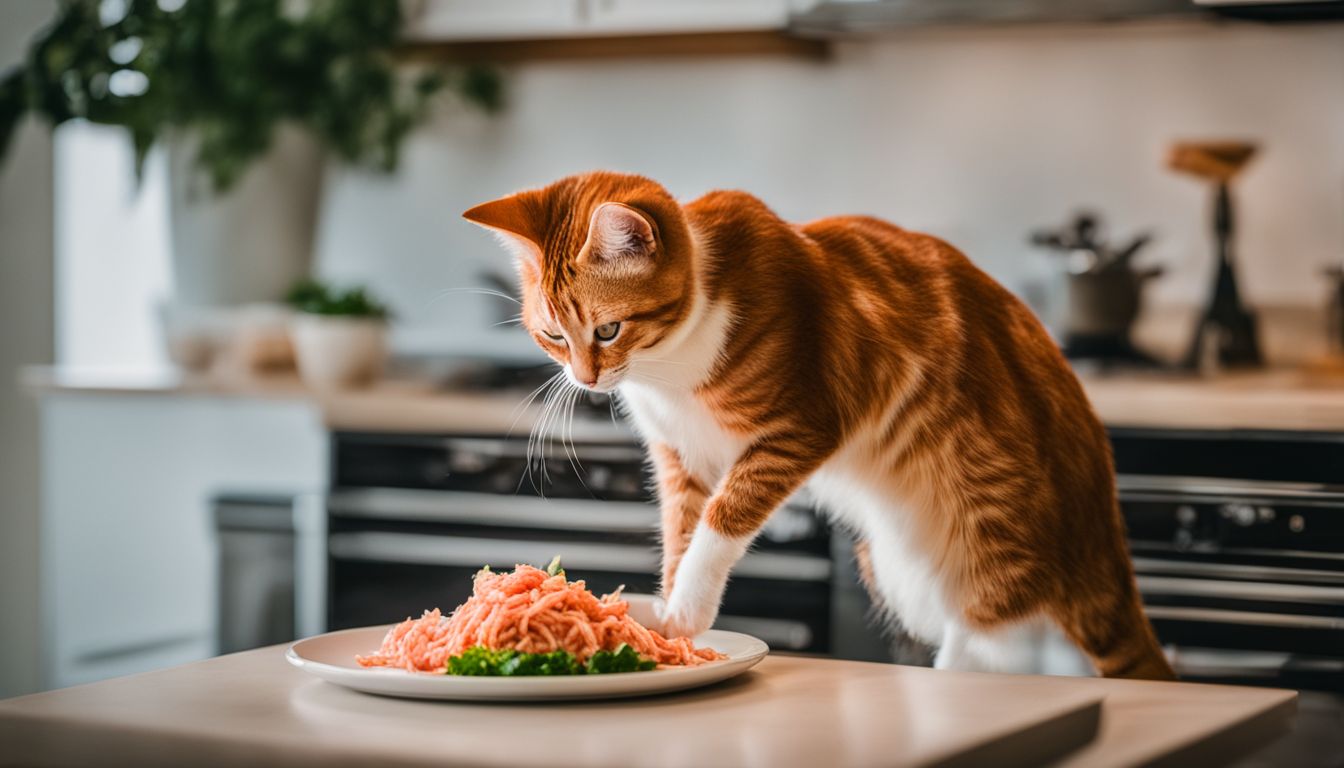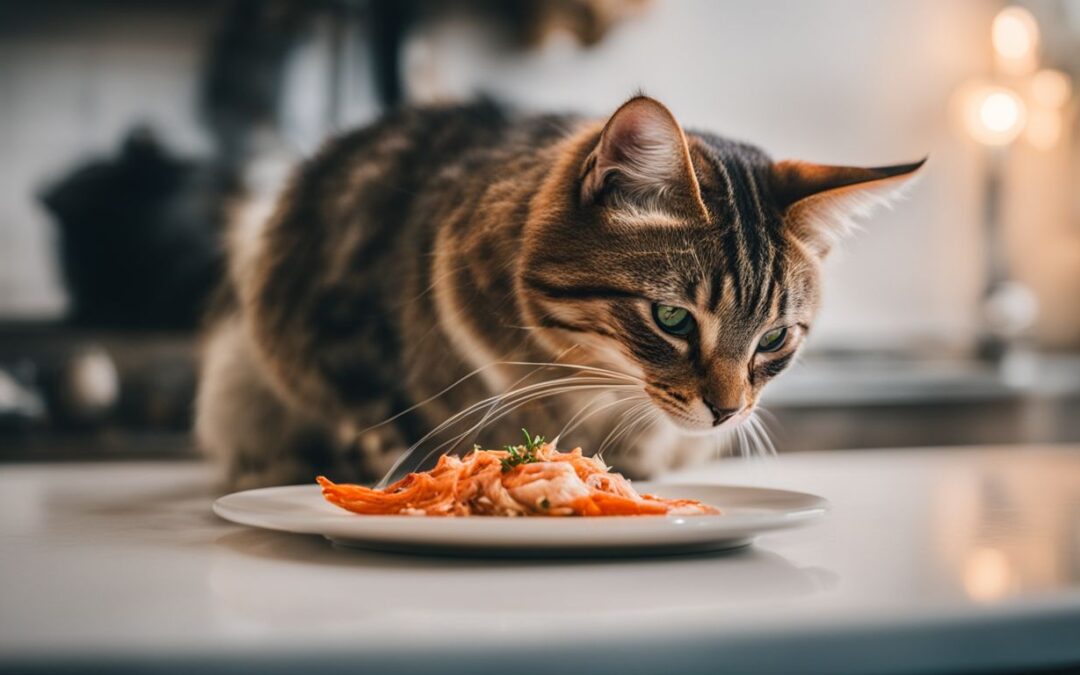You’ve got a cat, and you’re curious if those little bites of imitation crab are a safe snack for them. I totally understand the dilemma. After diving into some thorough research, I’ve uncovered some helpful insights.
This article is your go-to guide for understanding what’s okay and what’s not when it comes to letting your furry companion indulge in this popular seafood alternative. Ready to dive in? Let’s get started.
Key Takeaways
- Imitation crab, made from fish paste and flavored to taste like crab, contains carbs and additives not suitable for cats.
- Feeding your cat imitation crab can lead to digestive issues, affect kidney function due to high sodium levels, and trigger allergies.
- Instead of imitation crab, offer your cat cooked seafood like lobster or chicken without spices as healthier alternatives.
Understanding Imitation Crab

Imitation crab, also known as surimi, is a type of seafood made from fish paste. It’s shaped and flavored to look and taste like real crab meat. But it’s not just any fish thrown in there; mainly, white-fleshed fish are used.
They grind these fish up until they’re really smooth—kinda like how you’d mash potatoes. Then, they add stuff to make it taste good—like salt, sugar, and sometimes MSG.
But here’s the kicker: while it might fool our taste buds into thinking we’re enjoying luxurious crab meat, for cats, it’s a different story. This treat is packed with carbs and extras that our feline friends don’t need.
Cats are obligate carnivores which means their diet should be mostly meat. They require specific nutrients found in animal products—not something imitation crab offers much of.
Now let’s talk about whether this snack can actually fit into your cat’s diet or if it might do more harm than good.
Is Imitation Crab Safe for Cats?

Is imitation crab safe for cats? Let’s dive into the complexities of this topic. While it may seem like a tasty treat for your feline friend, there are potential risks to consider.
Potential Risks
Sure, imitation crab might look like a tasty treat for your furry friend. But, here’s the scoop: it’s packed with carbs and stuff like added salt, sugar, and things to keep it fresh – not so great for cats.
Cats need specific amino acids that this seafood twin just doesn’t have. Feed them too much of this, and they could miss out on what they really need to stay healthy.
Also, giving your cat the legs or shell bits is a no-go. They’re super hard to chew and digest. Imagine trying to munch on something as tough as nails – ouch! Plus, these parts can wreck their mouth or even hurt other places inside if swallowed wrong.
So yes, while sharing is caring, maybe keep the fake crab on your plate and off theirs.
Nutritional Value
So, I’ve talked a bit about why imitation crab isn’t the best snack for our furry friends. Let’s shift gears and chat about what’s actually in it that might impact our cats if they sneak a bite.
You see, imitation crab is lacking in the good stuff our carnivorous pals need. We’re talking real meat proteins, vitamins, and minerals that support their health from nose to tail.
Instead, this fake crab is packed with carbs and salt—not exactly prime cat food.
Cooked lobster meat tells a different story though—now that’s a treat worth considering! It’s like hitting the nutrition jackpot with all those amino acids. Think of amino acids as tiny building blocks for your cat’s health—keeping their fur shiny and their body lean and strong.
Plus, lobsters don’t bring along unwanted extras like sugar or preservatives found in imitation crab. So maybe next time you’re feasting on some seafood, flick a piece of lobster their way instead of the fake stuff—it’s just better all around!
Effects of Imitation Crab on Cat’s Health
Imitation crab may cause digestive issues in cats due to thiaminase, an enzyme that breaks down thiamine. It can lead to vomiting and even pose a choking hazard. Nutritional deficiencies from imitation crab could also affect a cat’s overall health.
Impact on Kidney Function
Imitation crab, containing high sodium levels, can negatively impact a cat’s kidney function. The excessive amount of sodium can put stress on the kidneys, leading to hypertension and potential renal problems over time.
It is vital for cats to maintain a balanced diet that supports their overall health, including their kidney function.
Excessive imitation crab consumption in cats can lead to kidney issues due to its high sodium content. This places undue stress on the kidneys and may eventually result in hypertension and renal problems.
Potential Allergies
Moving on from the potential impact of imitation crab on kidney function, let’s talk about its potential to trigger allergies in cats. Cats can be allergic to seafood, and imitation crab may not be an exception.
Look out for any signs of allergic reactions after your cat consumes it. Artificial flavors and preservatives in imitation crab could upset their stomach or cause allergies due to additives present.
Keep a close eye on your feline friend for any unusual symptoms.
Alternatives to Imitation Crab for Cats
Cooked crab meat without seasoning or spices is a good option, and it’s safe for cats. Here are some alternatives that you can consider:
- Cooked lobster meat – it offers more nutritional value than crab.
- Canned tuna – it’s a simple and easily accessible protein source.
- Cooked chicken or turkey – these are lean meats that can be a good treat for your feline friend.
- Wet cat food rich in fish or poultry – look for products with high-quality ingredients to ensure balanced nutrition.
These alternatives provide variety and essential nutrients for your cat without the potential risks of imitation crab.
FAQs about Cats Eating Imitation Crab
Can cats eat imitation crab?
- How much imitation crab can I feed my cat?
- Cats can consume a small amount of imitation crab as an occasional treat, but it should not be a regular part of their diet.
- Can cooked crab meat replace regular cat food?
- Cooked crab meat can be given to cats as an occasional treat, but it should not replace regular cat food.
- What about the legs and shells of crab?
- Cats should not be given the legs and shells of crab to eat as they are difficult to chew, digest, and may lead to mouth and teeth damage.
Conclusion
After looking at the details, it’s clear that imitation crab is not a good choice for cats. While they can have cooked and shell-free crab meat in small amounts, imitation crab has high carbs and sodium which aren’t good for them.
It’s also important to avoid canned crab due to preservatives like salt or citric acid. Instead, opt for treats such as cooked shrimp, salmon, tuna, freeze-dried chicken or catnip.
When giving your cat crab meat, make sure it’s cooked and do not include shells. Stick to occasional servings as an extra treat but never let it replace their regular food.
Remember that raw crab is a no-go due to harmful bacteria and parasites!
For more information on what other human foods are safe for cats, check out our guide on whether cats can eat papaya.
FAQs
1. “Can my cat really munch on imitation crab, or is that a seafood no-go?”
Well, here’s the scoop – while your kitty might give you those big, begging eyes for some of your imitation crab snack, it’s not the best treat for them. Imitation crab isn’t toxic but doesn’t offer any real nutrition they need. Plus, it could mess with their digestion… and nobody wants that.
2. “What’s the deal with cats and seafood anyway? They seem to love it!”
Oh, absolutely! Cats often go bonkers over anything fishy – think canned salmon or even a little nibble of raw crab (though make sure it’s safe!). But remember, just because they like it doesn’t mean it’s good for them all the time. Moderation is key!
3. “I heard something scary about thiamine deficiency and fish… should I be worried?”
Ah, yes – you’re onto something important there! Feeding your cat too much fish can lead to thiamine deficiency since some fish break down vitamin B1 (that’s thiamine). Keep an eye out for weird neurological signs if they’re chowing down on lots of seafood.
4. “Are there any ‘safe’ human foods I can share with my feline friend?”
Definitely! While we’re steering clear of imitation crab and certain fishes due to potential issues (like that sneaky thiamine problem), cooked meats without added spices or sauces are usually okay in small amounts. Think plain chicken or turkey – yum!
5. “So what should I feed my cat to keep them healthy and happy?”
Cats are meat-eaters through and through; their bodies crave animal protein packed with taurine, vitamins B12 and omega 3 among others – basically everything they need to thrive! High-quality commercial cat food usually hits all these marks perfectly.
6.”Any final tips for keeping my kitty’s diet top-notch?”
Sure thing! Always ensure fresh water is available – hydration is super important alongside a balanced diet rich in nutrients from appropriate sources (sorry again, imitation crab). And hey – when in doubt about introducing new foods into their diet? A quick chat with your vet never hurts.






